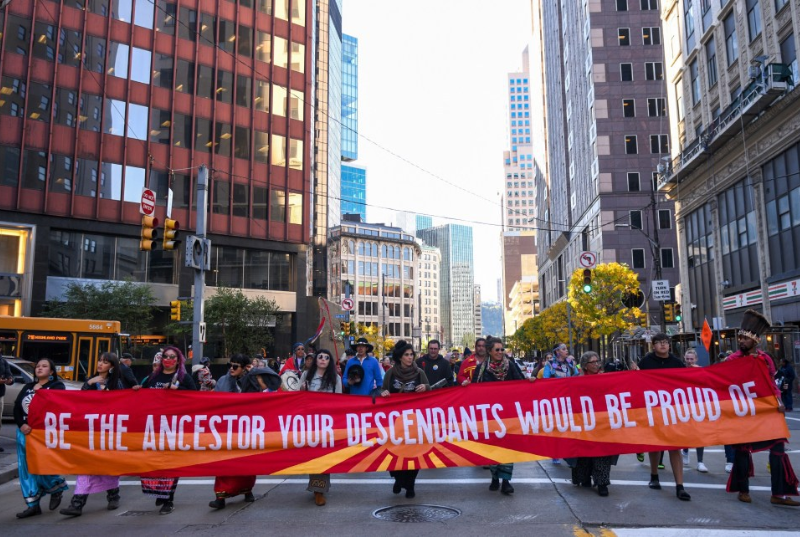On December 1, 2018, Amanda Dakota Webster, opens a new window (Diné) was found murdered in a Florence, Kentucky hotel room. At just 26 years old, she traveled to Kentucky as a contractor in construction to send money back home on the Navajo reservation in Arizona to help support her three sons. Her dream was to be a stay-at-home mother. Her life was tragically cut short at the violent hands of a non-Native man who admitted to the crime. Webster is just one of the hundreds of Indigenous women and girls who go missing or are murdered each year. The trial is still ongoing. The crisis of missing and murdered Indigenous women isn’t happening just on reservations. It’s happening across the continent. It’s happening in our own backyard.
According to the National Congress of American Indians Policy Research Center, opens a new window, Indigenous women are 2.8 times more likely to be murdered than non-Hispanic white women. More than 4 in 5 (84.3%) have experienced violence within their lifetime and more than half have experienced sexual and intimate partner violence. Indigenous survivors of violence are also less likely to receive the support and services they need to recover.
A vast majority (96%) of the heinous acts perpetrated against Native women are committed by non-Native men. The National Congress of American Indians Policy Research Center’s February 2018 report notes that, “The 2013 Reauthorization of the Violence Against Women Act (VAWA) included a historic provision reaffirming tribes’ inherent power to exercise Special Domestic Violence Criminal Jurisdiction (SDVCJ) over non-Indian perpetrators who commit acts of domestic violence, dating violence, or violations of certain protection orders in Indian Country. The law does not, however, cover sexual assault, stalking, or trafficking crimes.” This loophole allows non-Natives to commit violent crimes against Indigenous women with little to no consequence.
The Greater Cincinnati Native American Coalition, opens a new window (GCNAC) is one of the local organizations that is sounding the alarm and fighting back.
“According to the National Crime Information Centre, opens a new window database, there were 5,712 Native American women reported missing in 2016 and of those only 116 were entered into the Department of Justice’s missing person database,” said April Hester, GCNAC Education Coordinator. “Many cases go unreported so the statistics are likely higher. The insufficient data, shortage of police follow-through, and the lack of media attention all add to this national epidemic.”
In order to fully understand the epidemic, it’s important to understand the context; to understand the traumatic history of Indigenous people. “Native Americans continue to deal with the repercussions of colonialism, including removal from Native lands, forced assimilation, and Indian boarding schools, opens a new window,” said Hester. “A tragic result of historical trauma is the continued misunderstanding and prejudice toward Indigenous people, which is often a basis for the violence faced by Native women and girls.”
So, what can you do to help right now? One important thing you can do as an ally is to be a voice and raise awareness of this crisis. Native women have been working for this cause for years. Use your privilege or position to lift these Native voices to reach your audience online, people in your community, or dialogue with family and friends. Reject and speak out against harmful stereotypes and portrayals of Native people if you see them in your community or in pop culture. You can also contact your lawmakers and urge them to close dangerous legal loopholes, keep accurate data on missing and murdered Indigenous women, and pass legislation to combat the epidemic. GCNAC has a wonderful resource on its website directed specifically on how to be a good ally to the Indigenous community.
Between now and May 5, which is the National Day of Awareness for Missing and Murdered Indigenous Women, opens a new window, GCNAC is calling upon the greater Cincinnati community to hang a red dress in the window of their home or business.
The REDress Project was started by Anishinaabe artist Jamie Black and has been replicated worldwide, receiving global media attention. On February 4, 2020, GCNAC partnered with Cincinnati Playhouse in the Park to display their Red Dress Installation to bring awareness to the national crisis of missing and murdered Indigenous women and girls. After the Library re-opens to the public, the installation will be featured at the Downtown Main Library.
Share your Red Dress photos on social media by tagging @gcnativeamericancoalition, opens a new window on Facebook and @gcnacoalition, opens a new window on Instagram and use the hashtags #RedDressInstallation, #NoMoreStolenSisters, #MMIWG, and #MMIWAwareness. The Library also is sharing these images in solidarity on May 5.
“Indigenous women deserve better,” said Hester. “They deserve to be protected, but it is not just Native women who go missing. In Ohio, the stealing and trafficking of women is a serious issue. No one should go missing.”
The Greater Cincinnati Native American Coalition exists to preserve and represent the culture and heritage of Native American, Indigenous, and First Nations peoples by, but not limited to, providing education, advocacy, and support on contemporary Indigenous issues, and by cultivating knowledge about Native American history in local and regional communities. To learn more and get involved, please visit their website, opens a new window or email gcnacoalition@gmail.com.




Add a comment to: The Red Dress Installation: addressing the crisis of Missing and Murdered Indigenous Women and Girls